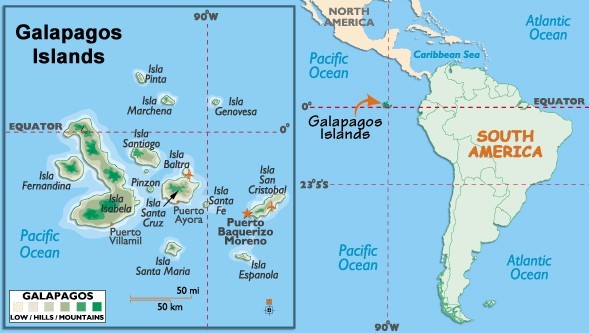Description

Disclaimer: Copyright infringement not intended.
Context
Scientists recently found two new coral reefs and two unexplored seamounts in the Galapagos Islands.
About
- It is an archipelago of volcanic islands.
- Location: The islands are located in the eastern Pacific Ocean, 973 km off the west coast of South America.
- Distribution: They are distributed on each side of the equator in the Pacific Ocean, surrounding the center of the Western Hemisphere.
- Country: It belongs to the Republic of Ecuador that lies 926 km to the east.
- Significance: The islands are known for their large number of endemic species that were studied by Charles Darwin during the second voyage of HMS Beagle.
- Galapagos Triple Junction: The islands are located at the Galapagos Triple Junction. The Galapagos Triple Junction is a geological area in the eastern Pacific Ocean several hundred miles west of the Galapagos Islands where three tectonic plates - the Cocos Plate, the Nazca Plate and the Pacific Plate - meet.
- The archipelago is precisely located on the Nazca Plate (a tectonic plate), which is moving east/southeast, diving under the South American Plate at a rate of about 2.5 inches (6.4 cm) per year.
- Climate: The archipelago is mainly characterized by a mixture of a tropical savanna climate and a semi-arid climate. It also transits into a tropical rainforest climate in the northwest.
- Highest Point: Mount Azul, at 5,541 feet is the highest point of the Galapagos Islands.
- Endemic Species: The islands are well known for their distinctive endemic species, including giant tortoises, finches, flightless cormorants, Galápagos lava lizards and marine iguanas, which evolved to adapt to islands' environments.
- Recognition: In 1978 the islands were designated a UNESCO World Heritage site.
- Exclusive Species: Galápagos marine iguana is a species of iguana found only on the Galápagos Islands (Ecuador).
.jpg)
Facts about Coral Reef Facts
- Corals are marine invertebrates (animals without a spine).
- Each coral is known as a polyp, and hundreds of them dwell together to form a colony, which expands as polyps multiply to make copies of themselves.
- Corals have a symbiotic association with zooxanthellae, which are single-celled algae.
- The algae offer food and nutrients to the coral by photosynthesis, which they perform using the sun's light.
- In turn, the corals provide a home for the algae as well as important nutrients. Corals get their vibrant colour from zooxanthellae.
|
PRACTICE QUESTION
With reference to Galapagos Islands, consider the following statements:
- The islands are located in the Western Pacific Ocean.
- It belongs to the Republic of Ecuador.
- The archipelago is precisely located on the Nazca Plate.
- In 1978 the islands were designated a UNESCO World Heritage site.
Which of the above statements is/are correct?
- A) 1 and 2 only
- B) 2, 3 and 4 only
- C) 1, 2 and 4 only
- D) 1, 3 and 4 only
Answer: B
|










